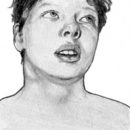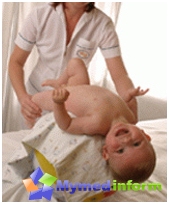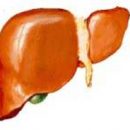What are the symptoms of sepsis? How to diagnose sepsis? Answers to these questions you will find in the article.
Content
Sepsis symptoms
Sepsis - a total purulent infection, which is a heavy
infectious disease complicating local
purulent inflammatory processes. Sepsis is called different
pathogens and their toxin
mi and expressed in a peculiar reaction of the body without
any specific manifestations.
Complaints of the patient diverse and do not always reflect the severity of his
State. When finding out complaints, it is necessary to pay attention to
Increase in temperature, its changes during the day, the presence of chill,
its duration and repeatability. It should be found out,
State of appetite and mental condition (euphoria, apathy).
With an external examination of the patient draws attention to the tired, sometimes
indifferent. Face at the beginning of the disease is often hypereced,
cheeks glow, but a few days later the face becomes pale.
The pallor of the skin of the face is especially expressed in chills. In Far Shedshy
Pallothies are combined with the vulnerament of the cheeks, the shade of the eyeballs
(Vwalled eyes).
Very early in acute sepsis appears
Scler and then skin and visible mucous membranes. The skin becomes
Dry, sometimes covered with sticky sweat. Pouring sweats
stunning oznoby, can be very pronounced, patients are forced to
the day of the day is changing underwear several times. In some cases, you can determine
on the skin of the inner surface of the forearm and leggy phetechial
hemorrhages, sometimes in the nide stains and stripes.
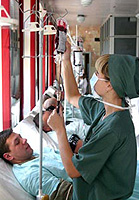 Quite often, at sepsis, herpes appear on the lips,
Quite often, at sepsis, herpes appear on the lips,
Increased bleeding of oral mucous membranes. In conjunctiva
eye can be point hemorrhages, lips, as a rule, pale, and in
Far cases with a shiny tint. In severe cases of sepsis
Breathing is difficult: the wings of the nose are swelling, neck muscles strain.
In some cases, the skin appears seals (infiltrates) with
Skin hyperemia over them, which indicates the appearance of purulent metastasis
infection. In places of skin compression (sacrum area,
The blades, the awesome processes of vertebrae, sedanized bugs) are determined
pronounced hyperemia, pale or necrosis of the skin, which is talking about
beginning or developed proleells who are pretty early
appear in patients with sepsis.
Increased body temperature in sepsis refers to constant
Symptoms. At the beginning of the disease or during the heyday, its temperature
The reaction is three species:
- Remiterative fever at which
The difference between the morning and evening temperatures is - 3° WITH,
observed in septicopemia (sepsis with metastases);
- constant
Fever when the temperature is constantly held on high numbers and
difference between
Morning and evening temperatures are 0.5° C, less often purulent sepsis,
occurs during septicemia;
- Wavely fever
during septicopemia: periods of subfebrile temperature after opening and
The drainage of the purulent focus is replaced by the rise of it to 39-40° C, that
due to the appearance of new purulent metastases. With tightened
sepsis, process transition to chronic temperature becomes
irregular not having any patterns. Feverish
the period can continue from several days to several months, in
The final stage of sepsis with pronounced body temperature
Usually normalizes.
The permanent symptoms of sepsis include octs. They are
correspond to massive outlet of foci of inflammation in the bloodstream
microorganisms or their toxins. The frequency of chills is
Various: they can repeat daily, several times a day or
A few days later. After the chills there is a significant increase
Temperature. Pretty constant symptom of sepsis is abundant
Poll.
Diagnosis of sepsis
Due to the inxication of the heart muscle during sepsis
(toxic myocarditis) Patients quite early appear
Pulse, as the disease develops, the filling of the pulse decreases,
Tachycardia is growing, reaching 120-140 UD / min. Pronounced tachycardia
It remains when the body temperature is reduced to normal or subfebrile.
The level of arterial and venous pressure decreases, especially sharply
with septic shock complicating the course of sepsis. Border hearts
Increased, the deafness and splitting of the tones are noted, weakening
Upper push, systolic noise. Cardiac noises are temporary
Character and with recovery of the patient disappear. When connected
ulceous endocarditis noises become permanent.
During septicopemia there are metastases of purulent infection in
Light with the rapid formation of abscesses or gangrenes of the lung. More often
Diffuse bronchitis and hypostatic (due to
Pneumonia ventilation). When examining patients usually
Bearing is noted (sometimes up to 30-50 per minute), cough with
a small amount of mucous membranes or mucous-purulent sputum, and when
Pneumonia - with abundant purulent wet. With percussion of NAD
The shortening of the percussion sound is determined, with auscultation -
Slow breathing, the appearance of attitudes and small-pushed wet
wheezing, respectively, the development of pneumonic foci.
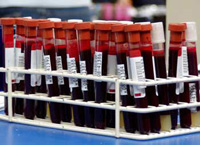 Patients with sepsis suffer from insomnia, often marked
Patients with sepsis suffer from insomnia, often marked
Noncritical attitude to its state
indifference and depression, sometimes euphoria. With high lifts
Temperatures of the body, the chills appear anxiety, excitement, nonsense.
Sometimes there is a confusion of consciousness, acute psychosis develops.
In the study of the gastrointestinal tract, the loss is noted
appetite, the presence of nausea, belching, sometimes exile
Ponosov associated with the development of Ahilia, a decrease in the pancreas function
glands, development of enteritis or colitis. Sometimes gastric or
intestinal bleeding, which are manifested by bloody vomit or
Degteny kaloma.
When inspecting the oral cavity, the dry language is covered with brown or gray
Skip, sometimes has crimson painting, in some cases gums
bleeding. With a long disease, cracks on the edges
Language.
The jaggility of the skin and the scool when sepsis meets a loyalty (
each fourth patient), but the level of bilirubin level
It is observed significantly more often. When palpation marks an increase
liver, the edge of it protrudes from under the rib arc, painful, moderately
Dense with hepatitis and flabby, soft at fatty dystrophy. At
Protecting sepsis developing cirrhosis.
When palpation of the belly in a patient with sepsis often determine
an increase in the painful loose contestation of the spleen, which
The measure of the development of the disease becomes dense.
With wound sepsis granulation in the wound from bright, red and
dense turn into pale, sluggish, watery, easily bleeding
When tapping. Epithelization of wounds stops. Separated wounds
scarce, serous-purulent, sometimes becomes dirty brown with
Silver smell. The swelling of the wound of the fabrics surrounding the wound is growing: edges
wounds are sealed, pale-blue color. Quite often join
Lymphangitis, lymphadenites, thrombophlebitis.
Changes in blood are constant. In patients
Anemia is rapidly developing: a few days from the beginning of the disease
The hemoglobin content is reduced to 70-80 g / l, simultaneously decreases
The number of erythrocytes to 3.0-1012 / l and below, anisocytosis is noted and
Poikilocytosis. The number of leukocytes changes: neutrophilic leukocytosis
more often within 8-15-109 / l, sometimes reaches 20-109 / l. Reduced
The content of lymphocytes and eosinophils up to the aezinophilia. Appearance
in the leukocyte formula of young forms and myelocytes while simultaneously
An increase in the toxic grit of neutrophils and aezinophilia
is an unfavorable prognostic sign. SE reaches 60 and
Even 80 mm / h with insignificant or moderate leukocytosis.
It is noted rapidly increasing hypoproteinemia: protein content
less than 70 g / l, in severe cases, lowered up to 60 g / l and even up to 50 g / l and
Below, the content of albumin is reduced to 30-40%, the level of globulin
Increases.
Respiratory failure, violation of exchange processes in
The body leads to a change in the acid-base state of the blood,
The development of acidosis. Changes in the coagulation and
Antiswriting blood systems: Decreases the content of Protromina,
fibrinogen, increasing fibrinolytic plasma activity and
The activity of heparin increases. Changes in the blood detected when
laboratory studies are not typical for sepsis, but
systematic study and when comparing with clinical data
Play an important role in establishing a diagnosis and in assessing the flow
Diseases.
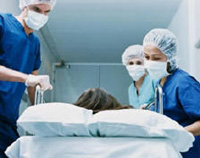 Bacteremia under sepsis refers to non-permanent symptoms, but
Bacteremia under sepsis refers to non-permanent symptoms, but
determined quite often (about 90% of cases). Blood for sowing on
Microflora should be taken many times at different times of the day at the height
Fever. Bacteriological studies are also exposed to urine,
Motica, pussy and exudate from wound or serous cavities. Selection
Microorganisms from the blood is an important diagnostic sign
sepsis, at the same time, negative sowing results when
The corresponding picture of the disease does not exclude a diagnosis of sepsis.
In the study of urine, low relative density detects,
protein, the amount of which increases as the disease,
Cylinders, leukocytes, bacteria.
The transition of the local purulent process to septic not always
manage to install immediately. The beginning of sepsis may be different:
The incubation period can be very short or last several
Days. Lightning sepsis starts suddenly, often with stunning
Chinkob. With acute sepsis, the beginning of the disease is preceded by the overall
weakness (drought), headaches, pain in the muscles and joints that
may continue within 2-3 days. Increase body temperature can
be permanent or sharp accompanied by chills.
With the lightning form of sepsis symptoms of the disease quickly
grow up. Often the primary hearth with this form of sepsis are
Furuncules and carbuncules of the face, in patients quickly develops swelling of the face,
The eye is closed as a result of fiber edema on the location side
purulent focus. They have a pronounced chills, raising
Temperatures up to 39-40° C, leukocytosis with a shift of blood formula left.
Patients are in terms of excitation, which is replaced by apatine,
On the 2-3rd day, the loss of consciousness comes, marked pronounced
Tachycardia (pulse rate up to 120-140 UD / min).
For acute sepsis, which occurs like septicemia, is characteristic
acute beginning in the presence of a primary hearth, as with a lightning
Sepsis. Patients have a high temperature, chill, pouring
Pot, often the skin of the skin and scool, rapidly increasing anemia,
Leukocytosis, liver and spleen increase. From the blood allocate
Microorganisms.
Appearance with a primary purulent focus and acute as
septicemia, the beginning of the disease in some organs (more often in the skin or
subcutaneous tissue, less frequent in the lungs) metastatic (secondary) purulent
Foci testifies to septicopemia.
The presence of a primary hearth is an indispensable condition for
Diagnosis of sepsis. With the appropriate clinical picture, but
An unbearable primary hearth to establish a diagnosis of sepsis follows
Eliminate acute infectious diseases (abdominal typhoid, para-typhus,
tuberculosis, brucellosis, tularemia) or systemic diseases
(collagenosis), blood disease, lymphogranulomatosis.
The permanent symptoms of sepsis include temperature rise
Body leukocytosis with leukocyte formula shift,
Progressive anemia, tachycardia, drop of blood pressure,
chills, pouring sweat.


